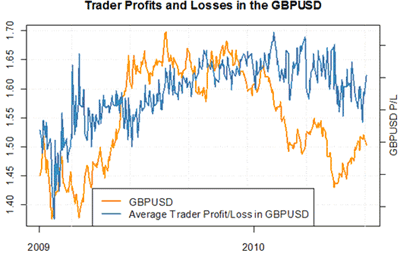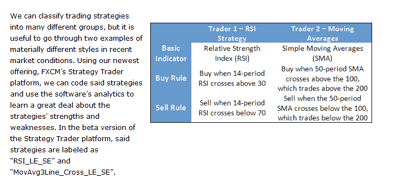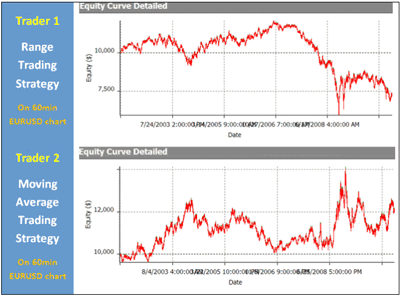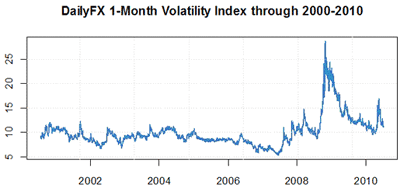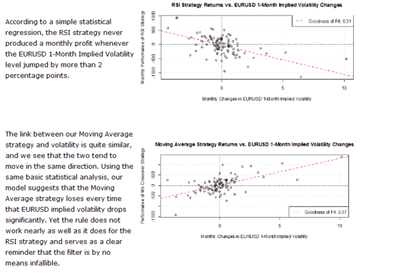US dollar volatility against the euro and other major currency pairs has made foreign currency trading more popular than ever, but the influx of new traders has often been met with the loss of old as many traders do poorly amidst volatile markets. But why do many traders fail at forex trading? Very often we find that common trading strategies have limitations that few understand. This article attempts to explain why some of the most popular currency trading strategies fail, and more importantly, how to fix them.
Why Does the Average Forex Trading Strategy Lose Money?
Both anecdotally and empirically, we have seen that many forex trading strategies are unable to profit due to 1) Poor money management techniques, and 2) Materially adverse market conditions. The first point is simple enough: Good money management means letting your profits run and cutting your losses short. A countless number of trading books advise traders to do exactly that, but we see time and time again that few are able to put such advice into practice.
The second point is less-often quoted but equally important: Many trading strategies tend to strongly underperform in specific market environments. If we can recognize a strategy’s limitations in certain circumstances, we can go a long way in protecting capital and preserving profits in unfavorable market conditions. Such dynamics go a long way in explaining why so many traders have lost money through especially volatile forex market environments.
Learning the Strengths and Weaknesses of Different Trading Strategies
The above trading strategies are approximations of two distinctly different trading styles, and examining the performance of each reveals many important details. First and foremost, we want to look at relative theoretical performance of these strategies.
Despite the moving average strategy’s impressive outperformance in our ten-year trading period, it remains clear that the range trading strategy was the better option for years at a time. In fact, it seems that moving average strategies lost money more often, only to make it back in several key instances.
Given such information, we should identify which circumstances we should look to trade using specific styles. Of course, it is virtually impossible to accurately predict which strategy will outperform within a given stretch of time. It subsequently remains critical to use sound money management techniques to protect against the unexpected.
NEXT: When to Range Trade and When to Trade MAs
|pagebreak|When Do We Range Trade and When Do We Trade Moving Averages?
Times of extremely high volatility almost always result in RSI range trading strategy losses, as major breakouts can easily leave currencies in strongly overbought or oversold territory for extended periods of time. Those same breakouts would clearly benefit a momentum-based trading strategy, and the above equity curves emphasize that our moving average trading generated substantial profits through recent price moves.
We need to find a filter that will tell us when to look to trade one type of strategy or look for another. At DailyFX, we often make reference to our volatility indices, which use implied volatility levels from forex options markets to gauge overall volatility expectations across key currency pairs. Implied volatility is a key component of forex options prices, and it gives an estimate on how much a given currency will move within a specific amount of time.
It is subsequently no surprise that our volatility indices correlate strongly to profits and losses from highly sensitive range trading and momentum strategies. In fact, we see a strong correlation between the euro/US dollar one-month implied volatility index and the performance of both our range trading and momentum strategies.
The strong relationship between performance and our predictive volatility index tells us that we can likely use this volatility measure as a tool to filter our trading strategies. With the benefit of hindsight, we see that the RSI strategy severely underperformed in months where the one-month volatility index reading increased significantly.
What’s the Moral of the Story?
We have taken two very common trading strategies and identified the proper market conditions for both. In doing so, we have identified when these trading strategies fail. Though it is unlikely that traders follow these strategies exactly, we can use the same concept on a wide range of similar trading styles. If a strategy depends on strong price breakouts or sustained momentum to turn profits, it would likely underperform during times of exceptionally low price volatility. Range trading strategies, by comparison, would outperform in such environments.
By David Rodriguez of DailyFX.com
DailyFX provides forex news on the economic reports and political events that influence the currency market
